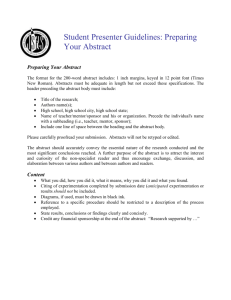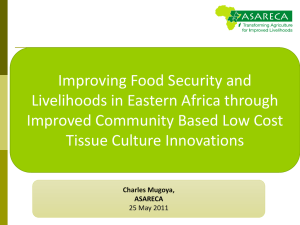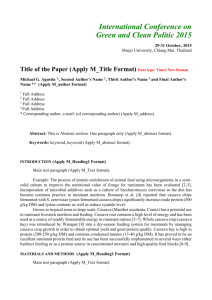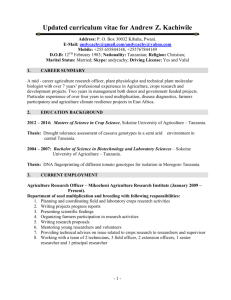Tropical Horticulture
advertisement
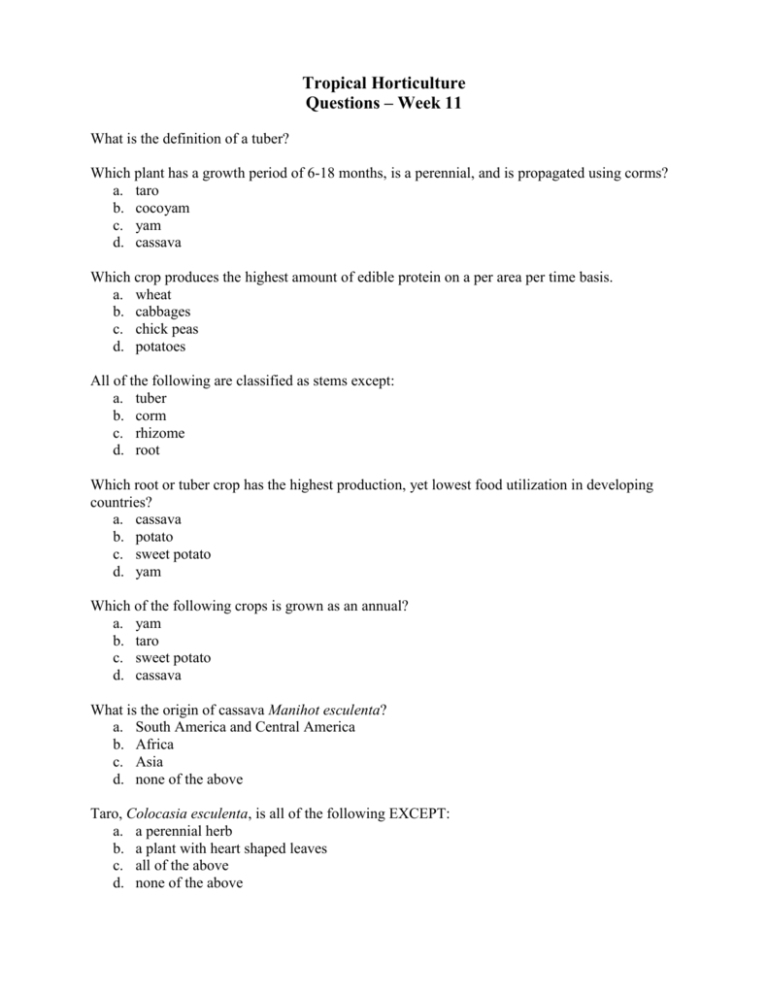
Tropical Horticulture Questions – Week 11 What is the definition of a tuber? Which plant has a growth period of 6-18 months, is a perennial, and is propagated using corms? a. taro b. cocoyam c. yam d. cassava Which crop produces the highest amount of edible protein on a per area per time basis. a. wheat b. cabbages c. chick peas d. potatoes All of the following are classified as stems except: a. tuber b. corm c. rhizome d. root Which root or tuber crop has the highest production, yet lowest food utilization in developing countries? a. cassava b. potato c. sweet potato d. yam Which of the following crops is grown as an annual? a. yam b. taro c. sweet potato d. cassava What is the origin of cassava Manihot esculenta? a. South America and Central America b. Africa c. Asia d. none of the above Taro, Colocasia esculenta, is all of the following EXCEPT: a. a perennial herb b. a plant with heart shaped leaves c. all of the above d. none of the above Which region produces the most cassava? Cassava is an excellent source of _______________. Potatoes have a short growing period and are therefore adapted to grow in the ____________ zone as well as the tropical zone. What two root and tuber crops have low fertility needs? How is cassava propagated? Cassava is the ________ of the lowland tropics. a. bean b. potato c. peanut d. bread Sweet cassava originated in_______, while bitter cassava originated in _______ and _______. a. Central America, Venezuela, and N. Brazil b. South America, Central America, and N. America c. China, India, and Africa d. Mexico, Brazil, and Asia T or F – A tuber is a fleshy underground stem. What percentage of potatoes is grown in the tropics? a. 25% b. 50% c. 70% d. 90% What is NOT a characteristic of a rhizome? a. root-like stem b. upper part with leafy stems c. lower part with roots d. underground buds Where does the sweet potato originate? a. Central America b. Africa c. Southeast Asia d. South Asia T or F – Cassava is adapted to acidic and infertile soils, but it cannot withstand freezing temperatures. What is rubber’s scientific name? T or F – Tapping of rubber is done late at night when it is dark. TROPICAL HORTICULTURE – QUESTIONS WEEK 11 – PAGE 2 What is the common name of Manihot esculenta? A tuber is: a. a fleshy underground stem b. bulblike underground upright stem c. root with no leaves or reproductive organs d. like a carrot T or F – A potato is a tuber. T or F – A yam is a tuber. What is the origin of the most important species of yam? What region yields the most yam production? Are yams annual or perennial? Name three root and tuber crops. Which of the following does NOT describe the Solanum tuberosum? a. an important staple crop b. herbaceous c. originated in the highlands of South America d. not a good source of carbohydrates What is the growth period for yams? a. 9-24 months b. 8-11 months c. 3-7 months d. 6-18 months Which tropical root or tuber crop has the most protein? a. cassava b. potato c. sweet potato d. yam e. aroids Which tropical root or tuber crop has the most vitamin A? a. cassava b. potato c. sweet potato d. yam e. aroids T or F – Cassava is a domesticated species. TROPICAL HORTICULTURE – QUESTIONS WEEK 11 – PAGE 3 Which tropical root or tuber crop has the most vitamin C? a. cassava b. potato c. sweet potato d. yam e. aroids The center of domestication of sweet cassava is located in: a. Central America b. South America c. Africa d. India Sweet potatoes are a: a. root b. tuber c. corm d. none of the above Which of the following comprises most of the world’s production of root and tuber crops? a. cocoyam b. taro c. yams d. sweet potatoes e. cassava f. potatoes Tapioca is another name for this root crop. a. yams b. cocoyam c. cassava d. taro No form of leaf is present on a a. root b. tuber c. corm d. bulb T or F – Cassava leaves are edible. The “potato” of the lowland tropics is: a. yam b. taro c. cassava d. sweet potato T or F - Rubber tree production is high in labor. TROPICAL HORTICULTURE – QUESTIONS WEEK 11 – PAGE 4 Low yields of cassava in Africa are caused by: a. low P and K b. high P and K c. high nitrogen d. SARS While tapping a rubber tree it is important not to damage: a. external bark b. latex vessels c. roots d. phloem sieve When a rubber tree is cross pollinated by the wind it is called: a. anemophilic b. entomophilic c. neither, it is hermaphroditic d. hermaphroditic How long will a rubber tree’s tapping schedule last? a. 4-5 years b. 7-10 years c. 20-25 years d. forever Where did the taro and yam (D. alata) originate? a. S.E. Asia b. Africa c. N. America d. S. America Which of the following root crops is tolerant of swampy soil? a. potato b. cassava c. taro d. cocoyam What is the Research Center for root and tuber crop in Peru called? a. CIAT b. IITA c. CIAP d. CIP T or F – A short, bulblike underground upright stem with scale-like leaves is a corm. Of all the root and tuber crops in the tropics, which crop has the highest production worldwide? How is cocoyam (elephant ear) propagated? T or F – Yam and sweet potato are the same thing. TROPICAL HORTICULTURE – QUESTIONS WEEK 11 – PAGE 5 Which of the following is NOT a common name for cassava? a. manioc b. mandioca c. tapioca d. taro e. yuca Why are root and tuber crops so important for “food insecure households”? Where is cocoyam (Xanthosoma sagittifolium) from? What are the scientific names for the sweet potato and the yam? What are the differences between roots, tubers, and corms? Which of the following crops is a vine? a. cassava b. potato c. yam d. taro Where is the most cassava produced? a. Africa b. Asia c. Americas d. Australia T or F – About one half of the potato production is in the temperate zone. Which category does the cocoyam fall into? a. root b. tuber c. corm d. rhizome e. bulb Which of the following is NOT a characteristic of the sweet potato? a. leaves variable in size, shape, color b. creeping herb c. enlarged roots vary in shape and color d. propagation: eyes from tubers Which of the following has the longest storage life “in the ground” AND “post harvest”? a. sweet potato b. yam c. potato d. cassava TROPICAL HORTICULTURE – QUESTIONS WEEK 11 – PAGE 6 Which of the following is the preferred propagation planting material for the taro? a. corms b. tubers c. vine cuttings d. stem cuttings Cross pollination by two different ways for the rubber tree, the first by wind, also known as _______________, and the second by insects, also known as _______________. Which of the following is NOT a characteristic of the rubber tree? a. trifoliate foliage b. laticiferous vessels c. produces latex flow twice a year d. monoecious flowering Describe where the latex vessels are located in a rubber tree In order to begin tapping a rubber tree for latex, the tree trunk circumference should be approximately: a. 45-50 cm b. 20-25 cm c. 55-60 cm d. 35-40 cm T or F – The prime growing region for the rubber tree is 20ºN and S of the equator. Rubber production is successful in ________________ and unsuccessful in _____________. a. South America and Asia/Africa b. South America/Asia c. Asia and Africa/South America d. Asia/South America What is a root? Give two examples. Why are root and tuber crops important? Give the scientific name of the “potato” of the lowland tropics (family, genus, species) Why is cassava considered an important crop? Cassava is a(n) ________________ with a cropping cycle of _______ months. a. annual/9months b. annual/9-12 months c. perennial/9-36 months d. perennial/9-12 months TROPICAL HORTICULTURE – QUESTIONS WEEK 11 – PAGE 7

